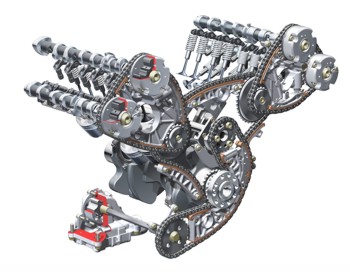Valve Train Dynamics
The steadily increasing requirements of government and customers concerning the efficiency and environmental friendliness of combustion engines, requires a more and more sophisticated control of the combustion process.
Active controllable valve trains provide comprehensive means of adjustment on the combustion process, but at an increasingly complex mechanical and control design.
To describe the dynamical behaviour of modern valve trains in an accurate way, the interaction between the different physical domains, i.e. mechanics, hydraulics and control electronics, have to be integrated in one consistent mathematical model.
Methods of non-smooth mechanics are applied to enable a highly efficient model of the system. Contacts and friction are described by set-valued laws and can be solved by methods of the convex analysis.
Thus, the necessity of difficult structure modification of the differential equation and the unintentional generation of high eigenfrequencies in the system, causing stiff differential equations, can be avoided. Therefore the numerical solution of this modelling approach facilitates the computation and is less costly.
These methods can also be assigned to general differential equations and provide a multitude of means for the simulation of hydraulics and control systems. Thus, e.g. hydraulic models like closing valves or cavitation without fluid elasticity can be described without the generation of irrelevant high eigenfrequencies or structural modification.
Additionally, extensive test rigs are designed and operated at the Institute of Applied Mechanics, which allow a verification of the applied simulation methods and models and an implementation and evaluation of control strategies under real operation conditions. The research of valve train dynamics at the Institute of Applied Mechanics is conducted in close cooperation with various partners in the automotive industries.
